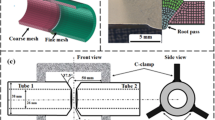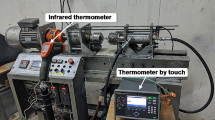Abstract
In consideration of uncertainties of material characteristics and its welding and forming process, an interval strain energy density method for predicting fatigue life of dissimilar lightweight metal welded joints was presented in this paper. Firstly, the mechanical performance parameters and fatigue properties of welded joints with parental material aluminum alloy 5083H111 and 5754 were obtained by experimental work. Based on the interval number approach, the interval relationship between the elastic and plastic strain energy density and fatigue life was constructed, including lower and upper interval bounds. Then, a finite element model of the dissimilar lightweight metal cross welded joint was generated to calculate the stress-strain response curve under cyclic loadings through the non-linear finite element analysis. The predicted lifetime and failure location for the cross welded joint based on the interval strain energy density method agreed well with the tested results.
Similar content being viewed by others
Abbreviations
- σ max :
-
Maximum tensile stress
- E :
-
Young’s modulus
- \({\bar \sigma _{ \pm \max }}\) :
-
Signed maximum equivalent stress
- ε p :
-
Plastic strain
- ΔW e+ :
-
Elastic strain energy density
- ΔW p :
-
Plastic strain energy density
- ΔW t :
-
Total strain energy density
- N f :
-
Fatigue life cycle
- A :
-
Strain energy density coefficient
- B :
-
Strain energy density exponent
- X I :
-
Interval parameter
- X C :
-
Midpoint value of the interval number
- y :
-
Dependent variable log10 (ΔWt)
- x :
-
Independent variable log10 (Nf)
- β 1 :
-
Coefficient for the linear term
- β 2 :
-
Coefficient for the constant term
- N :
-
Number of equation
- ε a :
-
Strain amplitude
- K′:
-
Cyclic strength coefficient
- n′:
-
Cyclic strain hardening exponent
References
Y. H. Li, Q. Qin, Y. D. Wang and M. G. Hu, Welded joint fatigue reliability analysis on bogie frame of high-speed electric multiple unit, Journal of Shanghai Jiao’ong University (Science), 22 (3) (2017) 365–370.
H. Jennifer and U. Thomas, Low cycle fatigue of welded very and ultra-high strength steels, Procedia Structural Integrity, 19 (2019) 259–266.
Z. Ibrahim, D. Buick and S. Luca, Experimental fatigue curves to perform the fatigue assessment of aluminium-to-steel thin welded joints, Procedia Structural Integrity, 18 (2019) 255–261.
Q. Y. Zhu, P. M. Lu and Q. Y. Xiang, Fatigue life evaluation of web butt welding structure on boom of excavator by hot spot stress approach, Engineering Failure Analysis, 113 (2020) 104547.
W. Shen, Y. Qiu, L. Xu and E. Liu, A semi-analytical formula for calculating the notch stress field of cruciform welded joint under bending loading, Fatigue and Fracture of Engineering Materials and Structures, 43 (11) (2020) 2637–2652.
K. Bao, Q. Zhang, Y. Liu and D. Jin, Fatigue life of the welding seam of a tracked vehicle body structure evaluated using the structural stress method, Engineering Failure Analysis, 120 (2021) 105102.
G. W. Yang, C. J. Che, B. Yang and J. J. Wang, Optimization research on S-N curve of ring welding structure based on structural stress method, Fatigue and Fracture of Engineering Materials and Structures, 42 (10) (2019) 2207–2219.
S. Y. Chen, D. S. Wei, J. L. Wang, Y. R. Wang and X. H. Jiang, A new fatigue life prediction model considering the creep-fatigue interaction effect based on the Walker total strain equation, Chinese Journal of Aeronautics, 33 (9) (2020) 2382–2394.
K. Hafida, B. Samira, B. Ahmed and J. P. Dron, Fatigue life prediction of upper arm suspension using strain life approach, Journal of Engineering, Design and Technology, 17 (1) (2019) 25–40.
Y. P. Wu, H. B. Liu, Z. H. Chen and Y. Liu, Study on low-cycle fatigue performance of aluminum alloy temcor joints, KSCE Journal of Civil Engineering, 24 (2) (2020) 195–207.
T. Belytschko and M. Tabbara, Dynamic fracture using element-free Galerkin methods, International Journal for Numerical Methods in Engineering, 39 (6) (2015) 923–938.
T. Belytschko and T. Black, Elastic crack growth in finite elements with minimal remeshing, International Journal for Numerical Methods in Engineering, 45 (5) (1999) 601–620.
X. L. Deng, F. G. Lu, H. C. Cui, X. H. Tang and Z. G. Li, Microstructure correlation and fatigue crack growth behavior in dissimilar 9Cr/CrMoV welded joint, Materials Science and Engineering A, 651 (2016) 1018–1030.
F. Ellyin, A criterion for fatigue under multiaxial states of stress, Mechanics Research Communications, 1 (4) (1974) 219–224.
H. Jahed, A. Varvani-Farahani, M. Noban and I. Khalaji, An energy-based fatigue life assessment model for various metallic materials under proportional and non-proportional loading conditions, International Journal of Fatigue, 29 (2007) 647–655.
S. Abdelhamid, B. Mohamed and M. Daniel, Fatigue failure study of the lower suspension vehicle arm using a multiaxial criterion of the strain energy density, Journal of Mechanical Engineering, 57 (4) (2011) 345–356.
F. Pakandam and A. Varvani-Farahani, A comparative study on fatigue damage assessment of welded joints under uniaxial loading based on energy methods, Procedia Engineering, 2 (1) (2010) 2027–2035.
C. J. Mi, Z. Q. Gu, H. G. Jian, Y. Zhang, W. T. Li and B. Yu, Frame weldment fatigue life prediction of electric dump trucks based on modified strain energy density method, China Mechanical Engineering, 30 (1) (2019) 96–104.
J. G. Yang, S. Wang, W. J. Zheng and Z. Chen, Uncertainty problems in modeling and numerical simulation in welding engineering, Welding Machine, 50 (9) (2020) 239–244.
P. H. Wirsching, Fatigue reliability for offshore structures, Journal of Structural Engineering, 110 (10) (1984) 2340–2356.
W. Scott and N. Alain, Probabilistic fatigue analysis of shop and field treated tubular truss bridges, Journal of Constructional Steel Research, 64 (2) (2007) 156–166.
D. W. Lee, S. Kim, K. Sung, J. S. Park, T. Lee and S. Huh, A study on the fatigue life prediction of tire belt-layers using probabilistic method, Journal of Mechanical Science and Technology, 27 (3) (2013) 673–678.
J. P. Sawyer and S. S. Rao, Strength-based reliability and fracture assessment of fuzzy mechanical and structural systems, AIAA Journal, 37 (1) (1999) 84–92.
S. P. Zhu, H. Z. Huang and Z. L. Wang, Fatigue life estimation considering damaging and strengthening of low amplitude loads under different load sequences using fuzzy sets approach, International Journal of Damage Mechanics, 20 (6) (2011) 876–899.
M. R. Wang, J. P. Fan and J. Hu, A non-probabilistic reliability-based design optimization method for structures based on interval models, Fatigue and Fracture of Engineering Materials and Structures, 41 (2) (2018) 425–439.
Z. P. Qiu, J. X. Hu, J. L. Yang and Q. S. Lu, Exact bounds for the sensitivity analysis of structures with uncertain-but-bounded parameters, Applied Mathematical Modelling, 32 (6) (2007) 1143–1157.
X. Q. An, Z. Q. Gu, X. K. Ma, S. Zhang and C. J. Mi, Fatigue life prediction method based on weld quality parameter interval model, China Mechanical Engineering, 28 (21) (2017) 2639–2645.
Z. Q. Gu and X. K. Ma, A feasible method for the estimation of the interval bounds based on limited strain-life fatigue data, International Journal of Fatigue, 116 (2018) 172–179.
J. B. Peng, G. Z. Kong, Y. J. Liu, F. C. Lu and H. Cheng, Low-cycle fatigue behavior of 5083H111 rolled aluminum alloy, Mechanical Engineering Materials, 39 (1) (2015) 39–41.
L. Fu, L. Li, M. D. Huang, Z. S. Liu and C. Liu, Research and application of material model for stamping and forming of aluminum alloy sheets, The Chinese Journal of Nonferrous Metals, 30 (1) (2020) 18–25.
Z. Q. Gu, C. J. Mi, Z. P. Ding and Y. Zhang, An energy-based fatigue life prediction of a mining truck welded frame, Journal of Mechanical Science and Technology, 30 (8) (2016) 3615–3624.
Acknowledgments
This work is supported by the Natural Science Foundation of Hunan Province (Grant No. 2020JJ6075 and 2020JJ6076 and 2021JJ50042).
Author information
Authors and Affiliations
Corresponding author
Additional information
Chengji Mi is an Associate Professor at School of Mechanical Engineering, Hunan University of Technology. He has completed Ph.D. in Hunan University. His research interests include fatigue life estimation and optimization design.
Rights and permissions
About this article
Cite this article
Ni, Z., Zhang, D., Xiong, T. et al. An interval-energy-based method for lifetime assessment of dissimilar lightweight metal welded joints. J Mech Sci Technol 36, 317–324 (2022). https://doi.org/10.1007/s12206-021-1229-1
Received:
Revised:
Accepted:
Published:
Issue Date:
DOI: https://doi.org/10.1007/s12206-021-1229-1




